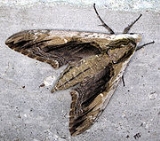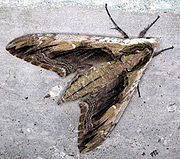
Ceratomia amyntor
Encyclopedia
The Elm sphinx, sometimes called the Four-horned Sphinx, is a North American species of moth
in the Sphingidae
family. It has a wingspan of 3¼ - 4½ inches (8.2 - 11.5 cm). As the name suggests, the larva
e (caterpillar
s) feed on elm trees (Ulmus), but they can also be found feeding on birch (Betula), basswood (Tilia
), and cherry (Prunus
). When the caterpillars are ready, they crawl to the bottom of the host
tree, where they crawl underneath the soil and pupate and may overwinter underground if late enough into the year.
west to Saskatchewan
and western North Dakota
and Colorado
; south to central Florida
, the Gulf Coast, Texas
, and New Mexico
.
, C. amyntor goes through a "wandering" phase where it stops feeding and burrows into the soil in order to pupate. Before pupating, the larva shrinks a considerable amount and then sheds its remaining skin that distinguishes it as a caterpillar, revealing its shell-like pupa.
, or adult, Elm Sphinx is a gray-brown with wavy markings covering the forewings. In the upper center of the forewings, as with other Ceratomia
species, there is a small white dot. The hindwings are a plain gray with a darker band running the length of the near-edge. The outer ends of the forewings and hindwings are both dashed with a light-dark-light pattern. Three broken, dark bands run the length of the body from the thorax to the tip of the abdomen. The antennae are stiff and wiry and have hook at the tips. Some specimens have a prominent splash of bright white on their upper head and wings and stand out considerably from other C. amyntor.

Moth
A moth is an insect closely related to the butterfly, both being of the order Lepidoptera. Moths form the majority of this order; there are thought to be 150,000 to 250,000 different species of moth , with thousands of species yet to be described...
in the Sphingidae
Sphingidae
Sphingidae is a family of moths , commonly known as hawk moths, sphinx moths and hornworms, that includes about 1,200 species . It is best represented in the tropics but there are species in every region . They are moderate to large in size and are distinguished among moths for their rapid,...
family. It has a wingspan of 3¼ - 4½ inches (8.2 - 11.5 cm). As the name suggests, the larva
Larva
A larva is a distinct juvenile form many animals undergo before metamorphosis into adults. Animals with indirect development such as insects, amphibians, or cnidarians typically have a larval phase of their life cycle...
e (caterpillar
Caterpillar
Caterpillars are the larval form of members of the order Lepidoptera . They are mostly herbivorous in food habit, although some species are insectivorous. Caterpillars are voracious feeders and many of them are considered to be pests in agriculture...
s) feed on elm trees (Ulmus), but they can also be found feeding on birch (Betula), basswood (Tilia
Tilia
Tilia is a genus of about 30 species of trees native throughout most of the temperate Northern Hemisphere. The greatest species diversity is found in Asia, and the genus also occurs in Europe and eastern North America, but not western North America...
), and cherry (Prunus
Prunus
Prunus is a genus of trees and shrubs, which includes the plums, cherries, peaches, apricots and almonds. There are around 430 species spread throughout the northern temperate regions of the globe. Many members of the genus are widely cultivated for fruit and ornament.-Botany:Members of the genus...
). When the caterpillars are ready, they crawl to the bottom of the host
Host (biology)
In biology, a host is an organism that harbors a parasite, or a mutual or commensal symbiont, typically providing nourishment and shelter. In botany, a host plant is one that supplies food resources and substrate for certain insects or other fauna...
tree, where they crawl underneath the soil and pupate and may overwinter underground if late enough into the year.
Range
C. amyntor can be found from Nova ScotiaNova Scotia
Nova Scotia is one of Canada's three Maritime provinces and is the most populous province in Atlantic Canada. The name of the province is Latin for "New Scotland," but "Nova Scotia" is the recognized, English-language name of the province. The provincial capital is Halifax. Nova Scotia is the...
west to Saskatchewan
Saskatchewan
Saskatchewan is a prairie province in Canada, which has an area of . Saskatchewan is bordered on the west by Alberta, on the north by the Northwest Territories, on the east by Manitoba, and on the south by the U.S. states of Montana and North Dakota....
and western North Dakota
North Dakota
North Dakota is a state located in the Midwestern region of the United States of America, along the Canadian border. The state is bordered by Canada to the north, Minnesota to the east, South Dakota to the south and Montana to the west. North Dakota is the 19th-largest state by area in the U.S....
and Colorado
Colorado
Colorado is a U.S. state that encompasses much of the Rocky Mountains as well as the northeastern portion of the Colorado Plateau and the western edge of the Great Plains...
; south to central Florida
Florida
Florida is a state in the southeastern United States, located on the nation's Atlantic and Gulf coasts. It is bordered to the west by the Gulf of Mexico, to the north by Alabama and Georgia and to the east by the Atlantic Ocean. With a population of 18,801,310 as measured by the 2010 census, it...
, the Gulf Coast, Texas
Texas
Texas is the second largest U.S. state by both area and population, and the largest state by area in the contiguous United States.The name, based on the Caddo word "Tejas" meaning "friends" or "allies", was applied by the Spanish to the Caddo themselves and to the region of their settlement in...
, and New Mexico
New Mexico
New Mexico is a state located in the southwest and western regions of the United States. New Mexico is also usually considered one of the Mountain States. With a population density of 16 per square mile, New Mexico is the sixth-most sparsely inhabited U.S...
.
Life cycle
C amyntor adults fly as a single brood in the northern portions from June-July. There are two broods further south, flying later into the year, and five broods have been confirmed in Louisiana from March-October.Egg
Tiny, translucent, lime-green eggs deposited on the underside of host leaves. The shells are transparent and pearly after hatching.Larva
Larvae come in two different color phases; a green phase, and a dark phase which differs in shades of brown, orange, and somewhat of a pinkish brown. Larvae complete all five instars within approximately one month. The first instar is the same shade of green as its egg. As the larva progresses through its instars, change in structure is noticeable. The caterpillar sports four, long, horn-like projections- in addition to the tail horn- from above its head, which is why the Elm Sphinx is sometimes called the Four-horned Sphinx.Pupa
As with other SphingidaeSphingidae
Sphingidae is a family of moths , commonly known as hawk moths, sphinx moths and hornworms, that includes about 1,200 species . It is best represented in the tropics but there are species in every region . They are moderate to large in size and are distinguished among moths for their rapid,...
, C. amyntor goes through a "wandering" phase where it stops feeding and burrows into the soil in order to pupate. Before pupating, the larva shrinks a considerable amount and then sheds its remaining skin that distinguishes it as a caterpillar, revealing its shell-like pupa.
Imago
The overall coloring of the imagoImago
In biology, the imago is the last stage of development of an insect, after the last ecdysis of an incomplete metamorphosis, or after emergence from the pupa where the metamorphosis is complete...
, or adult, Elm Sphinx is a gray-brown with wavy markings covering the forewings. In the upper center of the forewings, as with other Ceratomia
Ceratomia
Ceratomia is a genus of hawkmoths. Species include:-Species:*Ceratomia amyntor - *Ceratomia catalpae - *Ceratomia hageni - Grote 1874*Ceratomia hoffmanni - Mooser 1942...
species, there is a small white dot. The hindwings are a plain gray with a darker band running the length of the near-edge. The outer ends of the forewings and hindwings are both dashed with a light-dark-light pattern. Three broken, dark bands run the length of the body from the thorax to the tip of the abdomen. The antennae are stiff and wiry and have hook at the tips. Some specimens have a prominent splash of bright white on their upper head and wings and stand out considerably from other C. amyntor.

Food plants
- Ulmus (ElmElmElms are deciduous and semi-deciduous trees comprising the genus Ulmus in the plant family Ulmaceae. The dozens of species are found in temperate and tropical-montane regions of North America and Eurasia, ranging southward into Indonesia. Elms are components of many kinds of natural forests...
) - Betula (BirchBirchBirch is a tree or shrub of the genus Betula , in the family Betulaceae, closely related to the beech/oak family, Fagaceae. The Betula genus contains 30–60 known taxa...
) - Tilia (Basswood)
- Prunus (CherryCherryThe cherry is the fruit of many plants of the genus Prunus, and is a fleshy stone fruit. The cherry fruits of commerce are usually obtained from a limited number of species, including especially cultivars of the wild cherry, Prunus avium....
)
External links
- Ceratomia amyntor, Butterflies and Moths of North America
- Ceratomia amyntor, Sphingidae of the Americas

